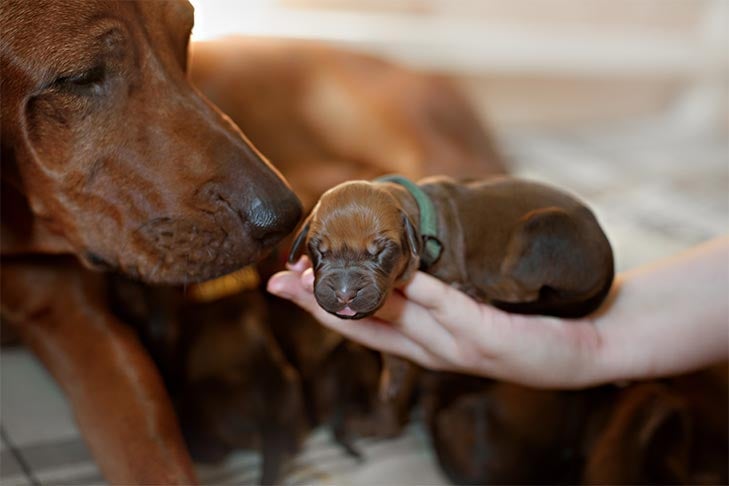Is this a whelping emergency? Am I jumping the gun? Am I waiting too long? Are the puppies in danger? Is the dam in danger? What should I do? Does she need a C-section? There’s not a breeder alive who hasn’t agonized over these same questions during a whelping. But take a deep breath, calm down, and take the time to make an informed decision.
Luckily, you can prepare for the case of an emergency Cesarean section, better known as a C-section. Planning ahead can actually start before you even breed your bitch by talking to your veterinarian about what to do. And if you’re still unsure, then call your veterinarian or an emergency clinic.
Preparing for an Emergency C-Section
As your bitch’s due date approaches, not only should you gather your whelping supplies, but also make plans just in case she needs an emergency C-section:
Determine her due date: Ideally, you performed progesterone testing during her heat cycle in order to pinpoint the exact date of ovulation. Whelping should occur between 62 and 64 days post-ovulation. Because bitches will mate for several days before and after ovulation, and sperm can live up to a week in her reproductive tract, if you don’t know the ovulation date then you can’t know definitely if your bitch is overdue until 72 days post-breeding. An alternative is to collect blood during her season and have your veterinarian save it without running progesterone tests to determine her actual ovulation date only when she seems late whelping.
Establish a veterinary relationship: Make your veterinarian part of your team by discussing pre-breeding tests and vaccinations, prenatal care, and what you should do should a whelping emergency occur either during or after regular office hours. Don’t expect a veterinarian who doesn’t know you or your bitch to rush in after hours or even squeeze you in between appointments.

Arrange for an after-hours emergency clinic: Your regular veterinarian may not be available after hours. Ask your veterinarian or other local breeders for suggestions for breeder-friendly emergency clinics. Then find out if they perform emergency C-sections and if they insist upon a mandatory spay along with the C-section.
Get pre-whelping X-rays: X-rays that were taken the week before her due date can determine the number of puppies, whether any are abnormally large, and whether they are full-term and thus likely to survive if delivered. A very small (one or two puppy) litter or a very large litter may be more likely to need a C-section. The puppies themselves elicit labor by producing hormones that affect the dam and with a very small litter, they may not produce enough hormones to induce labor. With a very large litter, the number of puppies may exhaust the dam before she can deliver all of them. You might consider a planned C-section in either case.
Use a whelping service: Consider using a monitoring service such as Whelpwise that supplies an external monitor that transmits information to a technician trained to interpret results. The results can indicate fetal distress, impending labor, or whelping problems such as uterine inertia, all of which would call for a C-section.
Know your breed: Be aware of any breed predispositions that could impact whelping. Breeds with a large head and narrow pelvis often have difficulty whelping naturally. Such breeds include the Bulldog, French Bulldog, Boston Terrier, Scottish Terrier, Sealyham Terrier, and Pekingese, among others. It may be preferable to schedule a planned C-section for these breeds.
Enlist the help of experienced breeders: Especially if you’re a novice breeder, having an experienced breeder by your side is one of the best precautions you can take. Perhaps your dog’s breeder is available, a member of a local kennel club, or a veterinary technician. You might offer to pay somebody to be on call or come to your home and help.
Be prepared in general: Don’t forget practical considerations, such as enough gas in your car to reach the veterinarian. Have friends who can accompany you or meet you at the veterinary clinic after hours in case extra hands are needed to revive puppies as one person per every one or two puppies is needed. Make sure to have a box to place the puppies in for the ride home, a blanket to keep the puppies and the dam warm on the ride home, and a tube-feeding or bottle-feeding equipment and formula ready in case the dam doesn’t accept the puppies immediately.
Time everything: Record the date of her ovulation, first and last breedings, temperature drop, the time she started labor, the time she started hard contractions, the time of each puppy’s birth, and the time between puppies. You and your veterinarian will likely need this information when deciding whether you have an emergency.
How to Know If a Dog Needs a C-Section?
If you’re experiencing any of the below concerns, call your vet immediately to ask about helping you with a safe birth or the potential of an emergency C-section. Anytime you aren’t sure, it’s better to err on the side of caution and get an informed opinion.
Is there a pus-like or bloody discharge? All vaginal discharge prior to giving birth should be clear, with one exception: a whitish stringy discharge may simply be the mucus plug shedding in the days or hours before whelping. This is normal and no cause for alarm. However, if the discharge is pus-like, the bitch may have a serious infection such as pyometra. Especially if she has an accompanying fever, this is a medical emergency requiring immediate after-hours veterinary attention whether she is pregnant or not. If the discharge is made up of large amounts of bright red blood, this is also a medical emergency that requires immediate veterinary attention. Some bloody discharge is normal during and after whelping, but if it is bright red and seems like too much, it may be an emergency.
Is there a green or greenish-black discharge? All vaginal discharge prior to giving birth should be clear. If the discharge is green it means that a placenta has separated from the uterine wall. If a greenish or greenish-black discharge occurs before the bitch is in labor, it could indicate one or more fetuses are dead. The bitch should be examined by your veterinarian to determine if the rest of the puppies are viable, but generally, a green discharge doesn’t warrant a C-section, especially if it is before her due date. If she has a greenish discharge during whelping, it is not a cause for alarm. While it is possible that one puppy could die, the rest of the litter is not in danger.

Has she been in Stage 1 labor for more than 12 hours? Stage 1 labor is the period preceding hard labor, usually indicated by restlessness, panting, digging, nesting, and shaking. Encouraging the dam to walk may help stimulate contractions. The veterinarian can feel for a puppy in the birth canal and take X-rays to determine if a puppy is too large or in the wrong position. Bloodwork can determine if calcium and glucose levels are off in the dam; if so, they may be supplemented to help labor.
Has she been in mild Stage 2 labor for more than 4 hours? Mild Stage 2 follows Stage 1 and is defined as intermittent hard straining. Your veterinarian can perform the same evaluation and treatment as for prolonged Stage 1 labor, and if that does not yield results, a C-section is indicated.
Have more than two hours passed between puppies being born? She may have whelped all her puppies, or she may be exhausted and unable to continue. If she is through whelping, she will generally settle with the puppies and nurse them. If she still has some left, she may continue to be restless. Walking the dam around the yard can help stimulate contractions and letting her eat something like ice cream, cottage cheese or whipped cream can help energize her. If a radiograph determines there are still many puppies to be delivered, and the bitch appears already fatigued, a C-section is needed.
Is the puppy in the wrong position? Normal birth presentation for dogs is either head or tail first, with front legs extended in front of the puppy, and rear legs presented stretched out behind the puppy. Abnormal positions include head first with front legs backward along the chest walls, or bent in different positions; rear first with hind legs facing toward the puppy’s head or in different positions; front first with the head bent to the side or backward, or side first. Because of the limited space, it is difficult to manipulate the puppy’s position, but you may be able to try using one or two fingers or a tiny tube to pass it beyond the puppy. The puppy will be very slippery, so using gauze will help you get traction. Warning: Do not use instruments, and do not pull on the puppy too hard, as it can separate joints, pull skin off, and even pull appendages such as the tail off. If gentle manipulation is unsuccessful, a C-section is needed.

